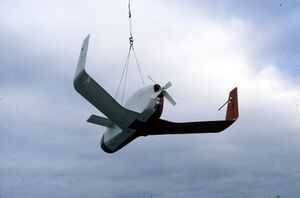Engineering:Boeing CQM-121 Pave Tiger
| CQM-121A / CGM-121B | |
|---|---|

| |
| YCGM-121B at the National Museum of the USAF | |
| Role | Anti-radar drone |
| National origin | United States |
| Manufacturer | Boeing |
| First flight | 1983 |
| Retired | 1989 |
| Primary user | United States Air Force |
| Number built | 13 (YCQM-121A) |
The Boeing CQM-121 Pave Tiger was an unmanned aerial vehicle developed by Boeing for use by the United States Air Force . Intended for the Suppression of Enemy Air Defenses (SEAD) role, the drone reached the flight-test stage before cancellation.
Design and development
The CQM-121 program began in 1983, with Boeing being awarded a contract for the development of a small drone aircraft that was intended for the suppression of enemy air defenses.[1] The resulting YCQM-121A, given the code name "Pave Tiger", was a tailless aircraft powered by a two-stroke engine.[2] The drones were to be fitted in 15-cell containers with wings folded; the sides of the container would open to allow for launch on a rail using a solid-fuel rocket booster. The aircraft would then follow a pre-programmed route, and could either use electronic countermeasures to suppress air defense systems, or use a small warhead to directly destroy them.[3]
Operational history
Flight testing of the 13 YCQM-121A aircraft began in 1983, however the following year the project was terminated.[3] The aircraft was resurrected in 1987, however, as an alternative to the AGM-136 Tacit Rainbow anti-radar missile; the anti-radar version, designated YCGM-121B and codenamed "Seek Spinner", first flew in 1988.[4] It was equipped with a warhead for the destruction of enemy radars, and could loiter while awaiting detection of an enemy radar set.[3] The program was terminated in 1989.[5]
Also in 1987, the U.S. Air Force ordered an electronic countermeasure version of the aircraft, given the designation YCEM-138A Pave Cricket. Equipped with an AN/ALQ-176 jammer, the program was also cancelled in 1989.[6]
Variants
- YCQM-121A Pave Tiger
- Original radar jamming variant; 13 built.
- YCGM-121B Seek Spinner
- Loitering anti-radar missile variant.
- YCEM-138A Pave Cricket
- Electronic countermeasures version of YCGM-121B.
Specifications (YCQM-121A)
Data from Parsch 2002[3]
General characteristics
- Crew: None
- Length: 6 ft 11.4 in (2.118 m)
- Wingspan: 8 ft 5 in (2.57 m)
- Height: 2 ft (0.61 m)
- Gross weight: 280 lb (127 kg) w/out booster
- Powerplant: 1 × Cuyuna Eagle 26.7 cu in (438 cc) two-stroke piston engine, 28 hp (21 kW)
- Powerplant: 1 × Solid rocket booster
Performance
- Maximum speed: 200 mph (320 km/h, 170 kn)
- Cruise speed: 90 mph (140 km/h, 78 kn)
- Range: 500 mi (800 km, 430 nmi)
- Endurance: 8 hours
- Service ceiling: 10,000 ft (3,000 m)
Armament
- Optional high-explosive warhead
References
- ↑ "USAF to accelerate drone". Flight International. July 16, 1983. p.123.
- ↑ Model Designation of U.S. Military Air Vehicles. DOD 4120.15-L. United States Department of Defense. May 12, 2004. Accessed 2014-04-08.
- ↑ 3.0 3.1 3.2 3.3 Parsch, Andreas. "Boeing CQM-/CGM-121 Pave Tiger/Seek Spinner". Directory of U.S. Military Rockets and Missiles. Designation-Systems. 2002. Accessed 2014-04-08.
- ↑ "Boeing flies Seek Spinner". Flight International. December 3, 1988. p.13. Accessed 2014-04-08.
- ↑ "Boeing YCGM-121B Seek Spinner ". National Museum of the United States Air Force. October 11, 2007. Accessed 2014-04-08.
- ↑ Parsch, Andreas. "Boeing CEM-138 Pave Cricket". Directory of U.S. Military Rockets and Missiles. Designation-Systems. 2002. Accessed 2014-04-08.
 |
